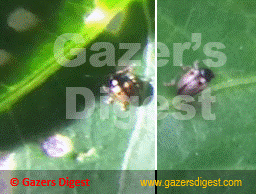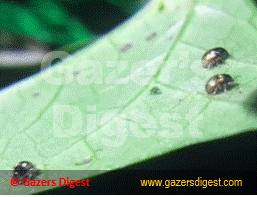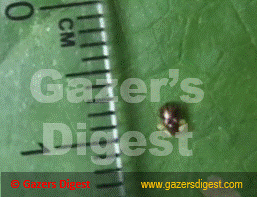
THE LEAF EATERS - 4
(A bicolor—gold coat with two black spots & black head—Beetle, Length Approx. 1.5 mm)
September 15, 2021

Except for a few small fresh leaves, almost all the leaves of a bean plant had holes. However, the plant survived.
I was wondering what was making holes in the bean leaves. There were some insects on the leaves but I could not see anyone was making a hole in any leaf.
SEARCHING FOR INSECTS
A few days later, at night, around 7.30 pm, I switched on my torch and began searching for insects.

I was able to observe a tiny beetle on a bean leaf.
The beetle, which measures about 1.5 mm in length, has a shiny gold coat with two black spots on its back. Its head is black.
I looked through a magnifying glass at the leaf, the holes in the leaf looked old.
On the following night, I observed three tiny beetles, which I had seen the day before, were on the underside of a bean leaf. However, I did not observe that these beetles were making holes in any leaf too.

FEEDING PATTERN
A few days later, during the daytime, I was able to observe one of the same beetles, while it was scraping a very small area on a leaf of another type of bean plant. After feeding on that area, it moved and began scraping another area.
It made a few holes, that is about 3-4 small areas were scraped, within an hour. Normally the holes are the same size as the beetle. That is the beetle can cover the area being scraped.

Later, I noticed, that the feeding pattern had not passed through the leaf. A thin transparent layer remained on the areas where the beetle had scraped the leaf.The small scraped areas are slowly losing the transparent layer.
These tiny beetles are highly vulnerable to predators during the day.
The images were captured as it was found happening in nature, and not enhanced using software. Images may be subject to copyright.

Home | Contact: info@gazersdigest.com
© 2020-2025 Gazer’s Digest is an information sharing platform. Gazer’s Digest includes topics, thought to be useful for the readers.